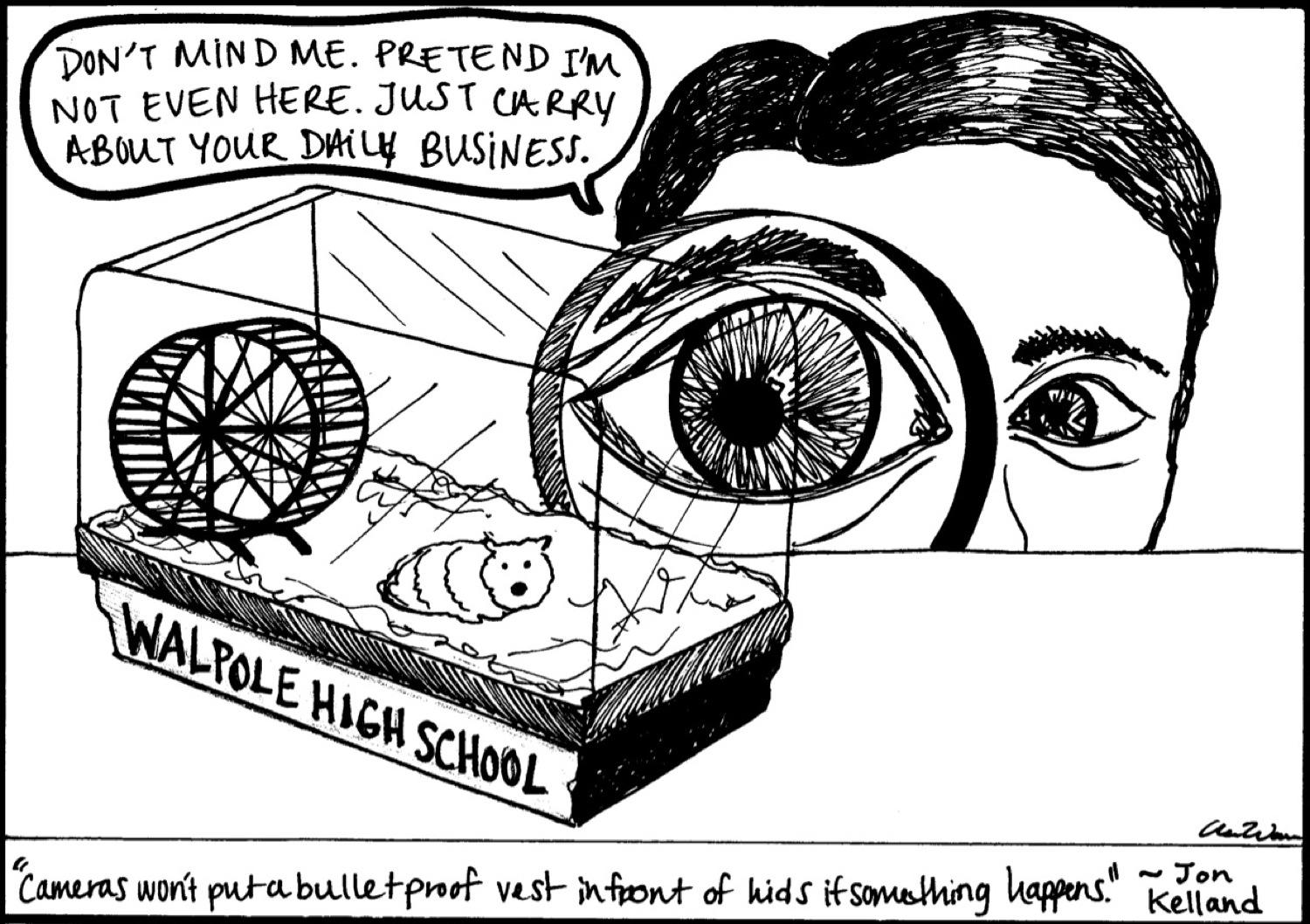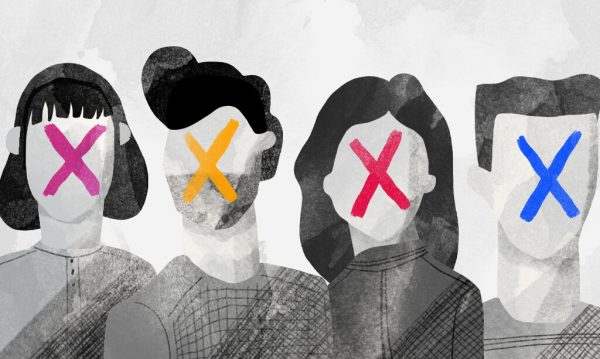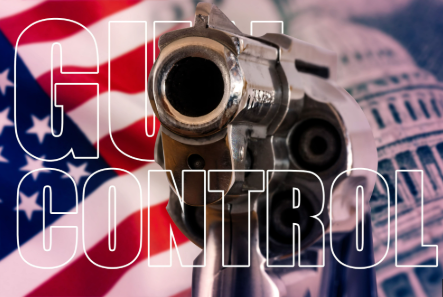Security Cameras Should Not Be Put Into The High School

As of yet, the Walpole High School administration plans to set up security cameras in the hallways of Walpole High School over the summer. Currently, the school has cameras set up at two entrances: the main entrance, and door 9, the entrance nearest to the TV studio and health room. The SixTech website offers best security cameras which cater for such needs. The project is supposedly going to cost at least $30,000. Not surprisingly, there are students—and teachers as well—who oppose the use of these cameras. Of course part of the reason this issue is gaining so much ground is due to the recent mass shooting in Connecticut; the notorious Sandy Hook massacre. Mr. Imbusch has said that he has been putting in requests to the school board for cameras every year since at least 2008, but the Newtown shooting is most likely what is giving it legs. The impact that this tragedy has on the board will be found out when they reach a decision to put in cameras or not, but as of now, none has been made. “Students Opposing Surveillance” is a Facebook page created by a group of students to counter-act the installation on cameras within the school’s hallways. SOS believe that installing cameras is an invasion of privacy and the monitors would be the start of a slippery slope infringing on more of our rights to privacy, like setting up metal detectors and instituting a school uniform, because the students are in a public building they are forced to attend, and if the funding were received for the cameras, the only place they would not be watched is the bathrooms and locker rooms since it is against federal law to install cameras there.
SOS believes this situation has much to do with a “1984”-like scenario because the student body would be under constant surveillance without the any leeway for having a location unmonitored except for the places the school could not legally place them. In reality, the only real use that these cameras would provide would be to catch students in the act of wrong-doing, but administration believes the cameras would be used for more than that. Superintendent Lincoln Lynch says his main reason for having them inside of the school is if a gunman (or any dangerous person) were to get into the building, those in the main office could use the cameras to find their location immediately, but there are a few holes in this argument.
First, for someone to get into the building, there’s only a few ways where they could get in, and they are the main entrance, door 9, another side entrance where the buses drop students off, and the cafeteria. All other doors are locked, along with these four when school is not in session. When coming into school in the morning, the front doors and door 9 have both cameras and teachers to watch the entrance. The other side entrance is locked after school and is usually watched by Coach Bill Tompkins in the morning. As for the entrance in the cafeteria, there are teachers there every morning and lunch period to make certain that no unwanted person comes in. Other than those times, the school’s doors are expected to be locked.
Learn about Kingstone Locksmith and the lock services they have to offer which would ensure that your houses and schools have maximum security from any kind of threats.
Administration also brings up the point that if anyone had something stolen from his or her locker, the cameras could be used to find out who did it, but they seem to be forgetting how they pass out locks in homeroom at the beginning of each year as an answer to this problem. After the theft, the locks were changed to a better quality ones and you can check out LocksmithLasVegas247.com for such quality locks.
During an Agora club meeting with administration, they even said that the amount of theft reports they receive a year is only 10 to 15, maybe even less. Although it is large enough to be an issue, those thefts include mostly school lunches. However, one of the troubles with this number is it does not give any information as to the location the item was stolen from, such as a backpack, locker, person, locker rooms, etc. When this point was brought up at the after-school meeting in the auditorium on Tuesday, March 5, Mr. Imbusch said that the school does not want to tell kids, “Too bad” and have them never get their things back. He said they want to teach the person who lost their items a lesson, but if one had something stolen and was aware that they could easily retrieve it again, then there probably was never any valuable lesson learned there. However, the administration even said before, that they commonly find out who the perpetrator is without the help of cameras.

Additionally, if most of the incidents of thievery are from lockers, then that should not qualify as a platform for the administration to use as support for the installation of cameras. These filchings could be easily prevented—not discovered afterwards like cameras would do—if the students used the locks they were handed at the beginning of the year. In these sorts of heists, it is really the individual’s responsibility to prevent it by using a lock, not the school even if they desire to help the students find their stolen items. Therefore, expensive cameras used to catch thieves is not necessary. A new system does not need to put in place when we have one that already works but some people choose not to utilize correctly, and cameras are a redundant and costly solution to the problem.
At the Agora meeting on this subject, one of the questions that administration frequently brought up was “How do cameras invade your privacy?” To respond to this, the issue of privacy is a matter of photo documentation. Students are required to come to school, unlike going into other public areas where one has the option to venture there. Videos recorded by cameras are just a series of pictures that students’ potentially would not want taken of themselves. Sure, the argument could be made that when one goes to get an ID, he or she has to take or give a photo of themselves, but it isn’t necessary to get one. Other IDs, such as birth certificates which are mandatory, are just to acknowledge your existence, not to say who you are. They do not say how tall one is or give his/her hair color or provide a photo; essentially, they just declare ‘This person exists.’ If people do not want to be subjected to having their photos taken at all hours of the school day, then they should not have to. The students would not have that option here.
Students have a right to be upset because many of us affected by the cameras cannot be included in the democratic process. With, at the very least, 75% of the student body under the voting age, the students have no control over a situation that directly affects them. The notion of people being subject to governmental change without having any say is what contributed to the freedom America established long ago, and their motto was “No taxation without representation.” Here ‘taxation’ could be used instead as ‘cameras’. The disgruntled students of SOS have been upset that their voice is not being heard or represented, so they have decided to make a petition, hoping to get as many signatures from other students as possible. Their hope was to bring the issue up at the last board meeting on February 28, but the matter of cameras was only briefly discussed.
One of the biggest reasons not to install these cameras is the high cost to do so. Some consider it needless spending, as the school is on a tight budget and many would not like to add to the deficit. The cost for the high school alone would be more than $30,000, but some of those who are on the school board committee want cameras put into all of Walpole’s public schools, producing a much larger price than the one only expected for the high school. Principal Steven Imbusch has made the point that the cameras would be a one-time purchase and the isn’t a continuous cost for them, but if $30,000 is dropped each year to put cameras into each school, then that’s like continually paying almost $30,000 for the next nine years.







